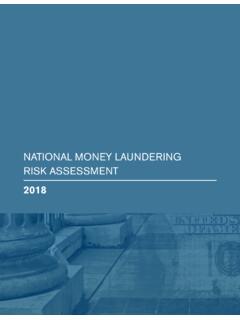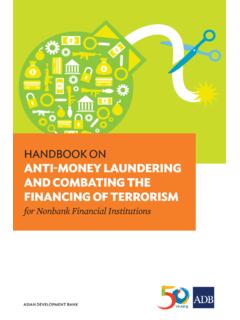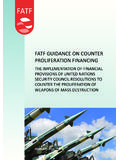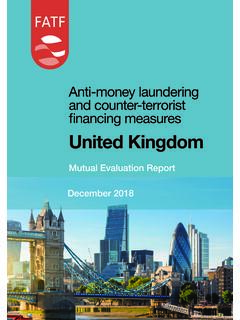Transcription of Anti-Money Laundering and Sanctions Rules and Guidance
1 Anti-Money Laundering and Sanctions Rules and Guidance (AML) AML AML 1 TABLE OF CONTENTS The contents of the AML Rulebook are divided into the following Chapters and sections: 1. INTRODUCTION .. 1 Jurisdiction .. 1 Application .. 1 Responsibility for compliance with the AML Rulebook .. 2 2. OVERVIEW AND PURPOSE OF THE AML RULEBOOK .. 3 3. INTERPRETATION AND TERMINOLOGY .. 7 Interpretation .. 7 Glossary for AML .. 7 4. GENERAL COMPLIANCE REQUIREMENTS .. 16 General requirements .. 16 Groups, branches and subsidiaries .. 17 Group policies .. 17 Notifications .. 18 Record keeping .. 19 Annual AML Return .. 21 Co-operation with the Regulator .. 21 Employee disclosures .. 21 5. APPLYING A RISK-BASED APPROACH TO AML .. 22 The risk-based approach .. 22 6. BUSINESS RISK assessment .. 23 Assessing business AML risks .. 23 Anti-Money Laundering systems and controls .. 24 7. CUSTOMER RISK assessment .. 26 Assessing customer Anti-Money Laundering risks .
2 26 Prohibition on Establishing Business Relationships with Certain customers .. 31 AML ii 8. CUSTOMER DUE DILIGENCE .. 34 Requirement to undertake Customer Due Diligence .. 34 Timing of Customer Due Diligence .. 36 Customer Due Diligence requirements .. 38 Enhanced Customer Due Diligence .. 43 Simplified Customer Due Diligence .. 45 On-going Customer Due Diligence .. 46 Failure to conduct or complete Customer Due Diligence .. 48 9. RELIANCE AND OUTSOURCING OF Anti-Money Laundering COMPLIANCE .. 49 Reliance on a third party .. 49 Business partner identification .. 52 Outsourcing .. 54 10. CORRESPONDENT BANKING, WIRE TRANSFERS, ANONYMOUS ACCOUNTS AND AUDIT .. 55 Application .. 55 Correspondent banking .. 55 Wire transfers .. 56 Audit .. 58 Anonymous and nominee accounts .. 58 11. Sanctions AND OTHER INTERNATIONAL OBLIGATIONS .. 59 Resolutions and Sanctions .. 59 Government, regulatory and international findings.
3 60 12. money Laundering REPORTING OFFICER .. 63 Appointment of a MLRO .. 63 Qualities of a MLRO .. 64 Responsibilities of a MLRO .. 65 Reporting .. 65 13. Anti-Money Laundering TRAINING AND AWARENESS .. 67 Training and awareness .. 67 Frequency .. 68 Record-keeping .. 68 14. SUSPICIOUS ACTIVITY REPORTS .. 69 Application and definitions .. 69 AML iii Internal reporting requirements .. 69 External Suspicious Activity Report .. 71 Suspension of Transactions and no tipping-off requirement .. 72 Record-keeping .. 72 Freezing of assets .. 72 15. DNFBP Registration and supervision .. 73 Guidance .. 73 DNFBP Prohibition .. 74 Criteria for Registration as a DNFBP .. 74 Application for Registration as a DNFBP .. 74 Grant of an Application .. 75 Refusal of an Application .. 75 DNFBP Notifications .. 75 Suspension and withdrawal of DNFBP Registration .. 76 Disclosure of regulatory status .. 76 Co-ordination between the Regulator and the Registrar of Companies.
4 77 16. Non-profit organisations ( NPOs ) .. 78 Responsibility for NPO compliance .. 78 Record Keeping .. 78 Cooperation .. 78 AML 1 1. INTRODUCTION Jurisdiction (1) The AML Rulebook is made in recognition of the application in the Abu Dhabi Global Market ("ADGM") of the Federal AML Legislation. (2) Nothing in the AML Rulebook affects the operation of Federal AML Legislation. Application (1) Subject to (2), the AML Rulebook applies to: (a) every Relevant Person in respect of all its activities carried out in or from the ADGM; and (b) the Persons specified in Rule as being responsible for a Relevant Person's compliance with the AML Rulebook. (2) In respect of a Relevant Person that is: (a) an Authorised Person (other than a Credit Rating Agency) and a Recognised Body, only the requirements of Chapters 1 to 14 of the AML Rulebook apply; (b) a Representative Office only the requirements of Chapters 1 to 6 and 11 to 14 of the AML Rulebook apply; (c) a DNFBP, only the requirements of Chapters 1 to 9 and 11 to 15 of the AML Rulebook apply; and (d) an NPO only the requirements of Chapter 16 of the AML Rulebook apply.
5 Guidance 1. Chapters 7 to 9 of the AML Rulebook deal with customers. As a Representative Office does not have customer these chapters do not apply. 2. Chapter 10 of the AML Rulebook deals with correspondent banking, electronic transfer of funds and audits. 3. Relevant Persons should consider these Chapters and determine which provisions apply. To assist Relevant Persons the following table sets out the application of the AML Rulebook to each of the different types of Relevant Persons specified in Rule (1). This table is for Guidance purposes only. AML 2 Application table Relevant Person Applicable Chapter(s) Authorised Person (other than a credit Rating Agency) or Recognised Body 1 - 14 Representative Office 1 - 6 11 - 14 DNFBP 1 - 9 11 - 15 NPO 16 Responsibility for compliance with the AML Rulebook A Relevant Person's Governing Body is responsible for establishing, maintaining and monitoring the Relevant Person's AML policies, procedures, systems and controls and compliance with applicable AML legislation.
6 A Relevant Person's Governing Body must ensure the policies, procedures, systems and controls referred to in Rule are effective to meet the obligations of the Relevant Person. (1) Responsibility for a Relevant Person's compliance with the AML Rulebook lies with every member of the Governing Body, and its Senior Management. (2) In carrying out their responsibilities under the AML Rulebook every member of a Relevant Person's Governing Body, its Senior Management and MLRO (as the case may be) must exercise due skill, care and diligence. (3) Nothing in this Rule precludes the Regulator from taking enforcement action against any Person, including any one or more of the following Persons, in respect of a breach of any Rule in the AML Rulebook: (a) a Relevant Person; (b) members of a Relevant Person's Senior Management; or (c) an Employee of a Relevant Person. AML 3 2. OVERVIEW AND PURPOSE OF THE AML RULEBOOK Guidance 1.
7 Under Section 15A of the Financial Services and Markets Regulations 2015 ("FSMR"), the Regulator has jurisdiction for the regulation of AML in ADGM. The AML Rulebook sets out the requirements imposed by the Regulator. The criminal law applies in the ADGM and, therefore, Persons in the ADGM must be aware of their obligations in respect of the criminal law as well as these Rules . Relevant criminal laws include Federal AML Legislation and Federal Law No. 3 of 1987 (the Penal Code of the United Arab Emirates). The Rules in the AML Rulebook should not be relied upon to interpret or determine the application of the criminal laws of the 2. The AML Rulebook has been designed to provide a single reference point for all Relevant Persons who are supervised by the Regulator for Anti-Money Laundering and Sanctions compliance in accordance with the scope of application outlined in Rule Accordingly it applies to Relevant Persons, but in different degrees as provided in Rule (2).
8 The AML Rulebook takes into consideration the fact that Relevant Persons have differing AML risk profiles. A Relevant Person should familiarise itself with the AML Rulebook, and assess the extent to which the Chapters and sections apply to it. 3. The AML Rulebook is not intended to be read in isolation from other UAE relevant legislation or developments in international policy and best practice and, to the extent applicable, Relevant Persons need to be aware of, and take into account, how these aforementioned matters may impact on the Relevant Person's day to day operations. This is particularly relevant when considering the list of terrorist organisations or persons issued under Article 63 of Federal Law No. 7 of 2014 on Combating Terrorism and the United Nations Security Council ("UNSC") Resolutions which apply in the ADGM, and Sanctions imposed by other jurisdictions which may apply to a Relevant Person depending on the Relevant Person's jurisdiction of origin, its business and/or customer base.
9 4. Chapter 1 specifies who is ultimately responsible for a Relevant Person's compliance with AML. The Regulator expects the Governing Body and Senior Management of a Relevant Person to establish a robust and effective AML and Sanctions compliance culture for the business. 5. Chapter 2 provides an overview of the AML Rulebook and Chapter 3 sets out the key definitions in the AML Rulebook. 6. Chapter 4 outlines the general compliance requirements including Group policies, notifications, record keeping requirements and the annual AML Return. 7. Chapter 5 explains the meaning of the risk-based approach ("RBA"), which should be applied when complying with the AML Rulebook. The RBA requires a risk-based assessment of a Relevant Person's business (in Chapter 6) and its customers (in Chapter 7). A risk-based assessment should be a dynamic process involving regular review, and the use of these reviews to establish the appropriate processes to match the levels of risk.
10 No two Relevant Persons will have the same approach, and AML 4 implementation of the RBA and the AML Rulebook permits a Relevant Person to design and implement systems and controls that should be appropriate to their business and customers, with the obvious caveat being that such systems should be reasonable and proportionate in light of the AML risks . The Regulator expects the RBA to determine the breadth and depth of the Customer Due Diligence ("CDD") which is undertaken for a particular customer under Chapter 8, though the Regulator understands that there is an inevitable overlap between the risk-based assessment of the customer in Chapter 7 and CDD in Chapter 8. This overlap may occur at the initial stages of on-boarding of customers but may also occur when undertaking on-going CDD. 8. Chapter 9 sets out where a Relevant Person may rely on a third party to undertake all or some of its CDD obligations.





